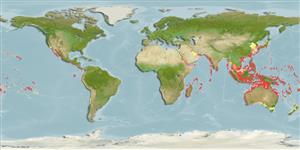Common names from other countries
Environment: milieu / climate zone / depth range / distribution range
Ekologi
; kisaran kedalaman 0 - 65 m (Ref. 101209). Tropical
Indo-Pacific.
Length at first maturity / Size / Weight / umur
Maturity: Lm ? range ? - ? cm Max length : 9.5 cm SHL jantan/; (Ref. 349); common length : 4.0 cm SHL jantan/; (Ref. 349)
The common species is collected for food by coastal people in many parts of the area (Ref. 349). Inhabits rocky and coral-rock bottoms, or on stones and larger shells. Also found in shallow subtidal zones (Ref. 349). Members of the family Patellidae graze on encrusting lichens and algae, or scrape tissue from kelp (Ref. 349).
Life cycle and mating behavior
Kematangan | Reproduksi, perkembang biakan | Pemijahan | telur-telur | Fecundity | Larva
Members of the order Archaeogastropoda are mostly gonochoric and broadcast spawners. Life cycle: Embryos develop into planktonic trocophore larvae and later into juvenile veligers before becoming fully grown adults.
rujukan utama
Acuan | Koordinator | mitra
Poutiers, J.M. 1998. (Ref. 349)
Status IUCN Red List (Ref. 130435)
status CITES (Ref. 108899)
Not Evaluated
Not Evaluated
ancaman kepada manusia
Harmless
penggunaan manusia
| FishSource |
Alat, peralatan
informasi lanjut
Umur / Saiz
Pertumbuhan
panjang-berat
panjang-panjang
Morfologi
Larva
Kelimpahan
Sumber internet
Estimates based on models
Preferred temperature
(Ref.
115969): 22.3 - 29, mean 27.8 (based on 1014 cells).
keancaman
Low vulnerability (10 of 100).
